Film & Movies
Disney’s long, long journey to Oz
In honor of the 50th anniversary of the very first telecast of "The Wizard of Oz," Jim Hill tracks the Walt Disney Company's interest in L. Frank Baum's characters. Beginning with "The Rainbow Road to Oz" and ending right on the steps of Disneyland Paris' Emerald City

It was 50 years ago tonight that the 1939 version of "The Wizard of Oz" was first shown on television.
Copyright 2005 Warner Home Video
The first-ever telecast of this Victor Fleming film was a rating smash. Over 44 million people tuned in to catch this broadcast (Which was hosted by the Cowardly Lion himself, Bert Lahr as well as by Judy Garland's then-10-year-old daughter Liza Minnelli).
CBS executives (Who had aired this Academy-Award winning motion picture as part of a special extended version of the "Ford Star Jubilee" program) were obviously thrilled with those ratings. But you know who was even happier? Walt Disney.
"Why Walt Disney?," you ask. Well, you see, Walt had long been a fan of L. Frank Baum's "Oz" books. In fact, back in the mid-1930s, just as Disney Studios was starting to search for a story that would serve as a suitable follow-up to "Snow White and the Seven Dwarfs," Walt had Roy inquire about the movie rights to the original "Wizard of Oz" book.
Unfortunately, the Baum family had just sold the rights to this best-selling fantasy novel to rival mogul Samuel Goldwyn for some $60,000. Which is how Disney Studios missed out on the chance to make an animated version of "The Wizard of Oz."
But even though this initial opportunity had slipped through Walt's fingers, he never lost his enthusiasm for the Oz books, their colorful characters and spectacular settings. Which is why — in 1954 — when the movie rights to 11 of Baum's books became available (I.E. "The Emerald City of Oz," "Glinda of Oz," "The Lost Princess of Oz," "The Magic of Oz," "Ozma of Oz," "The Patchwork Girl of Oz," "Rinkitink in Oz," "The Road to Oz," "The Scarecrow of Oz," "Tik-Tok of Oz" & "The Tin Woodsman of Oz"), Walt quickly snatched them up.
Mind you, back then, Walt wasn't thinking about bringing Oz back to the big screen. But — rather — he wanted to use some of the Baum books as possible fodder for episodes of his new ABC television series, "Disneyland." Toward that end, the studio hired TV writer Dorothy Cooper to adapt "The Patchwork Girl of Oz" to the small screen.
In April of 1957, Ms. Cooper turned in an outline for a proposed two-part episode of the "Disneyland" TV series which was initially supposed to be called "Dorothy Returns to Oz." However, by August of that year, when Dorothy turned in her fleshed-out version of this teleplay, the project was then titled "The Rainbow Road to Oz."
Copyright 1957 Walt Disney Productions
Walt read Dorothy's teleplay and liked it. Quite a bit. In fact, Walt liked this script so much that he took "The Rainbow Road to Oz" off of the studio's television development track and moved this project over to the feature side of the house.
At that point, the studio's publicity department kicked things into high gear. Press releases were sent out to the trades announcing that Walt Disney Productions would begin shooting "The Rainbow Road to Oz" in November of that same year. This multi-million dollar live action musical was to have been directed by Sidney Miller and produced by Bill Walsh. Who — at that time — were both playing huge parts in the day-to-day production of "The Mickey Mouse Club."
And speaking of "The Mickey Mouse Club," guess who was supposed to have filled most of the major roles on this motion picture? That's right. The Mouseketeers.
So with just a few months 'til production was actually supposed to begin on "The Rainbow Road to Oz," Disney's design team threw themselves into the project. Using William Denslow & John R. Neill's original illustrations for inspiration, these artists quickly created a costume design for the Scarecrow …
Copyright 1957 Walt Disney Productions
… as well as the Patchwork Girl.
Copyright 1957 Walt Disney Productions
Then after figuring out what Oz might look like …
Copyright 1957 Walt Disney Productions
… These artists handed these plans over to the studio's fabrication staff. And quicker than you can click your heels together three times …
Copyright 1957 Walt Disney Productions
… Oz and its colorful characters had been brought to life on a barren soundstage on the Burbank lot.
As you can see by the costume design that Disney artists put together for the Cowardly Lion …
Copyright 1957 Walt Disney Productions
… Walt was going for a look that was reminiscent of the MGM movie but not actually derivative.
Copyright 1957 Walt Disney Productions
The way I hear it, the production staff most enjoyed working on the characters who had not appeared in the 1939 film. Take — for example — Ozma.
Copyright 1957 Walt Disney Productions
The "Rainbow Road to Oz" design team put together an outfit of Ozma that Annette Funicello just adored. So much so that — after she completed shooting the wardrobe tests for this character — Annette begged to be allowed to wear her Ozma wig home. So that she could then show off her faux long locks to her family.
Copyright 1957 Walt Disney Productions
So as you can see, in the late summer / early fall of 1957, "The Rainbow Road to Oz" seemed to be on Disney Studio's fast-track. A 15-minute-long segment of the season opener of the "Disneyland" show (Which — FYI — will be included as part of the "Walt Disney Treasures — Your Host, Walt Disney" DVD that will be hitting store shelves on December 19th) was devoted to this forthcoming film. With the conceit of this portion of the "Fourth Anniversary Show" being that the Mouseketeers were trying to sell Walt on the idea of turning "The Rainbow Road to Oz" into a movie …
Copyright 1957 Walt Disney Productions
Which is why Annette, Doreen Tracey, Darlene Gillespie and Bobby Burgess were supposedly all in costume, appearing in possible musical numbers for this proposed motion picture …
Copyright 1957 Walt Disney Productions
But it was Walt — rather than the Mouseketeers — who was really pushing to get this movie made. Even going so far as to acquire the rights to a 12th L. Frank Baum book, "Dorothy and the Wizard of Oz," for an amount that was said to be the equivalent of what the studio had paid for the first 11 books.
But then the previously-announced start-of-production date in November came and went. And then — by February of 1958 — rumors began circulating that Disney had abandoned plans to shoot "The Rainbow Road to Oz." That Walt had suddenly tabled this project and was now searching for a more suitable production to serve as his studio's entry into the world of live action musicals.
Why did Walt suddenly flip-flop on "The Rainbow Road to Oz." Over the years, I've heard a variety of explanations about the abrupt cancellation of this project. They run the gamut from "The projected cost of production got too high" to "Walt didn't think that the Mouseketeers could carry the picture" to "The rewrite that Bill Walsh did of Dorothy Cooper's script didn't quite come together" to "The score that Tom Adair & Buddy Baker wrote for the movie wasn't nearly as strong as the score that Yip Harburg & Harold Arlen wrote for 'The Wizard of Oz.' "
Whatever the real reason was, Walt lost confidence in "The Rainbow Road to Oz." Though — that said — when he finally did decide on the property that would serve as a replacement for this proposed production, Victor Herbert's comic operetta, "Babes in Toyland" …
Copyright 1961 Walt Disney Productions
… Walt picked a project that had a surprising amount of things in common with "The Rainbow Road to Oz." Take — for example — "Babes in Toyland" 's storybook setting. Which was very reminiscent of what Disney had planned on doing with "The Rainbow Road to Oz." Then there's Annette Funicello …
Copyright 1961 Walt Disney Productions
… Who was originally supposed to play Ozma (Which was one of the lead roles in Disney's "Oz" picture) but wound up playing Mary in "Babes in Toyland" instead.
And it wasn't just "The Rainbow Road to Oz" that must have been weighing on Walt's mind as he over-saw the casting of "Babes in Toyland." Clearly Disney must have also been thinking about MGM's 1939 version of "The Wizard of Oz" when he began hiring people to appear in this picture. Otherwise, how do you explain how Ray Bolger …
Copyright 1961 Walt Disney Productions
… the Scarecrow from that Victor Fleming film wound up playing the villainous Barnaby in this Jack Donahue picture? Or — for that matter — how Ed Wynn …
Copyright 1961 Walt Disney Productions
(Who had actually been MGM's original choice for the title character in "The Wizard of Oz." But Wynn proved that he was indeed "The Perfect Fool" when MGM offered Ed the part in 1938 and he turned that studio down) wound up playing the Toymaker?
Truth to be told, the parallels between "The Rainbow Road to Oz" and "Babes in Toyland" run even deeper than this. Given that the real reason that Victor originally wrote his operetta back in 1903 was because the Broadway stage version of "The Wizard of Oz" had been so successful earlier that same season. Herbert's backers basically told him to " … write a show like 'The Wizard of Oz.' " Which is how Victor wound up writing the score for "Babes in Toyland."
Okay. Enough with the operetta history. Let's get back to the Disney / Oz saga, shall we?
Even though Walt had seemingly lost all enthusiasm for making a new "Oz" movie, that didn't mean that Disney had actually fallen out of love with Baum's characters. Truth be told, Walt was just looking for a new home for Dorothy and her pals. And — for a while, anyway — it looked like he had found one along the shores of the Storybook Land Canal Boats ride at Disneyland.
As the story goes, Walt proposed putting an addition on this Fantasyland attraction in the late 1950s. One that would have created a Big Rock Candy Mountain for the Casey Jr. Circus Train to climb as well as some new mysterious caverns for the canal boats to float through.
Copyright 1959 WED Enterprises
As to what would be hidden away deep inside the caves of the Big Rock Candy Mountain, Walt had the Imagineers design various tableaus featuring the lands of Oz …
Copyright 1959 WED Enterprises
… With the basic idea being that all of the characters were heading to the Emerald City to take part in a surprise birthday party for Dorothy.
Copyright 1959 WED Enterprises
It was Walt's hope that this new Oz-themed sequence would finally give Disneyland's "Storybook Land Canal Boats" ride a fitting finale. So blueprints were drawn up …
Copyright 1959 WED Enterprises
… Like the one pictured above. Which is for the Tin Woodsman's castle. And then models were made …
Copyright 1959 WED Enterprises
… and maquettes of the Oz characters were created. Below, you'll see the versions of the Wicked Witch and the Cowardly Lion that Joe Rinaldi designed.
Copyright 1959 WED Enterprises
But in the end, Walt opted not to go forward with construction of this Oz-themed expansion of the Storybook Land Canal Boat ride. No one that I've ever spoken with about this proposed Disneyland addition can come up with a logical explanation. Except perhaps that while a Big Rock Candy Mountain may have looked good on paper, the full-sized dimensional model that the Imagineer built using real candy was distinctly unappetizing.
What is certain is that Walt was still very fond of the Oz characters. Given that he kept many of the maquettes that had been created for the Storybook Land expansion project on display in his formal office (I.E. The area where Disney greeted guests & dignitaries that were visiting the Burbank studio) for years after that project had been tabled.
Yeah, Walt clearly wanted to do something with the Oz characters. Which is why — in 1965 — he had his staff invite Ray Bolger back to the Burbank lot, so that he could reprise his performance as the Scarecrow on a new Disneyland Storyteller album "The Scarecrow of Oz."
Copyright Walt Disney Productions
That LP was so well received that it was followed up by three other Oz-theme storyteller albums: "The Wizard of Oz," "The Cowardly Lion of Oz" and "The Tin Woodsman of Oz." (The "Cowardly Lion" album has always been of particular interest of Disney history fans. Given that it reportedly features several of the musical numbers that Tom Adair & Buddy Baker had originally written for "The Rainbow Road to Oz.")
Copyright Walt Disney Productions
But for the next 10 years, Disney executives basically did nothing with the Oz characters. And — with every day that ticked by — the options that Disney had held on those 12 L. Frank Baum books back in the 1950s were losing their value. Given that many of these titles — just like the original "Wizard of Oz" had — were getting ready to slip into public domain. Which meant that any studio could then produce an Oz picture.
Finally, in 1980, Tom Wilhite — the then-head of production at Walt Disney Studios — had had enough. He was tired of seeing the company produce this seemingly endless series of mediocre films. Particularly since the studio was sitting on the movie rights to this spectacular series of children's books. So Tom began searching for a director who'd be willing to tackle the Oz project.
To hear Walter Murch tell the story, "Tom had to work his way down to the Ms before he finally found me." Murch — an Academy-Award winning sound & film editor — may seem like a rather unlikely candidate to direct Disney's Oz movie. But Walter's pedigree (I.E. Murch had worked with Francis Ford Coppola on the "Godfather" films as well as George Lucas on "THX 1138") was impeccable. More to the point, given that Murch had just won an Oscar for his work on "Apocolypse Now," he had a fairly high profile at the moment.
So Murch was signed to both write & direct what was then known as "Oz" …
Copyright 1983 Walt Disney Productions
… (The "Return to Oz" title wouldn't actually be tacked onto the film 'til much further on down Disney's developmental track). And — when Wilhite first announced the project to the press in January of 1991 — he revealed that Dorothy would most likely not appear as a character in this picture. "We'll probably combine characters from various books and structure a new storyline."
But the screenplay that Walter would submit in the spring of 1982 did feature Dorothy as a character. It was also much darker in tone than the studio had been anticipating. Which caused Disney executives much concern.
Still, development of "Oz" continued. A veteran production designer, Norman Reynolds (Who had worked on "Star Wars V: The Empire Strikes Back" as well as "Raiders of the Lost Ark") was hired to bring Baum's world to life. And work then began on the various robotically-controlled characters that would be featured in the film …
Copyright 1982 Walt Disney Productions
At this point, some $6 million had already been spent by Walt Disney Productions on "Oz." And then — in November of 1983 — Richard Berger (I.E. The executive who had replaced Tom Wilhite as president of production at the studio) suddenly shut down production of the picture.
As Berger explained to the New York Times back in July of 1985:
''The budget was up to $27 million (Which was significantly higher than the $20 million that 'Oz' was originally supposed to cost) … The movie was supposed to (be shot in) Algiers, Sardinia, Spain, Canada, Kansas and England … All of Disney's recent movies had (gone) over budget. 'Something Wicked This Way Comes' had been $5 million over budget. (Which is why I) decided to close down the movie and write off the $6 million (that the studio had already invested in the picture).''
Eventually however a compromise was reached. "Oz" 's budget was pared back to $25 million. Which meant that virtually all of the movie's on-location sequences (Which would have sent the cast & crew off to Sardinia & Algeria to shoot the scenes set in the Deadly Desert, Kisserta near Naples to shoot the Nome King's throne room sequence and Hadrian's Villa outside of Rome for Mombi's palace as well as the ruins of the Emerald City) were scrubbed. Except for the scenes that were set in Kansas (Which were shot out on the U.K. 's Salisbury Plain, near where Stonehenge is located), the entire film would be shot on five soundstages at Elstree Studios.
The film (as Murch and his production team had originally envisioned it) never quite recovered from all these budget cuts. Though much time & effort had already been devoted to creating authentic likenesses of favorite old characters like the Scarecow …
Copyright 1983 Walt Disney Productions
… Now there was no money left in the budget for the complicated electronics that would have brought his face to life. Which is why the Scarecrow mostly had a fixed expression in the finished film.
As for Jack Pumpkinhead …
Copyright 1957 Walt Disney Productions
… A Baum character who had also been slated to have a featured role in "The Rainbow Road to Oz" … It often took as many as six puppeteers to bring Jack to life …
Copyright 1984 Walt Disney Productions
… Where even the seemingly simple act of standing up and/or sitting down involved all sorts of elaborate off-screen mechanics.
Photo by Jeff Lange
The "Return to Oz" shoot did not go well. Given that Fairuza Balk, the film's 9-year-old star, could only work 3 1/2 hours each day and that characters like Billina the talking chicken were notoriously difficult to operate, the production quickly fell behind schedule. At one point, Disney execs actually tried to remove Murch as director of "Return to Oz," only to have George Lucas intercede on Walter's behalf.
Once production was completed, Murch's movie had to deal with other problems. You see, by the time that "Return to Oz" had finally made out into theaters in June of 1985, Mouse House management had changed yet again. Now it was Michael Eisner & Jeffrey Katzenberg who were calling the shots in Burbank. And — to be honest — Michael & Jeffrey didn't know quite what to make of Walter's film. A PG-rated pseudo-sequel to 1939's "The Wizard of Oz" with no music that was often too dark & scary for small kids to handle.
So while "Return to Oz" may have been the centerpiece of an elaborate presentation at Radio City Music Hall that summer, around the rest of the country this Walter Murch film didn't receive very special treatment. At that time, noted author Harlan Ellison actually accused Disney Company management of deliberately sabotaging "Oz" 's chances at the box office. Which is why he urged his readers to " … go see it, before it disappears."
Copyright 1985 Walt Disney Productions
Luckily, thanks to VHS and DVD, "Return to Oz" has not disappeared. And while this movie may have been a real box office disappointment back in 1985 (Earning only $11.1 million during its entire domestic run), it has since gone on to be embraced by Baum enthusiasts around the globe. Who have applauded Murch's efforts to keep the look & style of this film consistent with that of L. Frank's books.
Still, it speaks volumes about what Michael Eisner must have really thought about "Return to Oz" when it came time to chose which films would be featured in "The Great Movie Ride" at Disney-MGM Studios. Michael could have made use of the characters & settings from Disney's own "Oz" picture for free. But he paid big bucks to Ted Turner for the rights to use the 1939 version of "The Wizard of Oz" instead.
The Imagineers then used the MGM film as inspiration for the various scenes that they wanted to include in the studio theme park's thesis attraction …
Copyright 1986 WED Enterprises
… They even made use of then-state-of-the-art Sarcos technology to create a scarily life-like Wicked Witch of the West in the ride's Munchkinland sequence.
Copyright 1989 The Walt Disney Company
Clearly, WDI has a thing when it comes to the 1939 version of "The Wizard of Oz." Otherwise, why else would they have included nods to that film in attractions like DCA's "Golden Dreams" and Walt Disney Studios' "CineMagique"?
Meanwhile, Disney Company execs seem eager to continue to cash in on the public's affection for the Oz characters. Take — for example — last year's "The Muppets' Wizard of Oz" …
Copyright 2005 Disney Enterprises
… or the deal that Disney & producer Jerry Bruckheimer signed with American McGee back in 2003 to produce a trilogy of films based on McGee's twisted & sinister Oz prequel. Which promised to make the formerly-thought-to-be-dark "Return to Oz" seem like a walk in the park.
Anyway … My apologies if today's article about Disney and the Oz books seems somewhat downbeat. An endless litany of projects that either didn't make it off the drawing board and/or ultimately didn't turn out as well as had been initially hoped.
'Cause — you see — that's not really the case. There is at least one Oz-related Disney project that turned out beautifully. Of course, in order to see it, you first have to journey to Disneyland Paris and then visit that theme park's "Les Pays des Contes de Fées" attraction.
Copyright 2002 Nouveau Millénaire
The very last thing that you see on this Fantasyland attraction is a beautiful miniature recreation of the Emerald City.
Photo by Eric Craven
And who's there waiting at the entrance to the city? Tiny versions of Dorothy, the Scarecrow, the Tin Woodsman and the Cowardly Lion.
Photo by Eric Craven
I don't know why it is — as a baby boomer — that seeing these characters there on the steps of the Emerald City just makes me smile. Maybe watching "The Wizard of Oz" all those years whenever the film aired annually on CBS has finally truly warped my brain.
Speaking of which … In honor of that very first telecast 50 years ago tonight, why don't you throw the 1939 version of the movie into your DVD player tonight? And remember (at least for a little while) what it was like to be a kid again, when you first saw Dorothy begin her journey down the Yellow Brick Road?
Copyright 2005 Warner Home Video
The above article is actually something that I've been working on — on & off — for about seven years now. In fact, if I remember correctly, when I initially came on board at MousePlanet, one of the very first story ideas that I ever pitched to Al Lutz was doing something about how Disney had tried to get all of these Oz-related projects off the ground since the 1930s.
Obviously, when you're writing an article like this, you have to do an awful lot of research. Which is why I'm grateful to Disney historians like Greg Ehrbar, Jim Fanning, Bruce Gordon, Ryan Harmon, Tim Hollis, Jack Janzen, Leon Janzen, David Mumford, Brian Sibley & Dave Smith and — on the Oz side of the house — Alan Eyles, John Fricke, Aljean Harmetz & Brad Munson for all the hard work that they did prior to me actually starting to put this piece together. Without all of the reference books and magazine & newspaper articles that these folks had written previously, today's article would not have been possible.
Thanks also to Eric Craven & Jeff Lange for providing photographic support for this piece. And the ever-wise & patient Nancy Stadler for scanning, comping & cropping all of the images that you see in today's story.
Film & Movies
How Disney’s “Bambi” led to the creation of Smokey Bear

When people talk about Disney’s “Bambi,” the scene that they typically cite as being the one from this 1942 film which then scarred them for life is – of course – the moment in this movie where Bambi’s mother gets shot by hunters.
Which is kind of ironic. Given that – if you watch this animated feature today – you’ll see that a lot of this ruined-my-childhood scene actually happens off-camera. I mean, you hear the rifle shot that takes down Bambi’s Mom. But you don’t actually see that Mama Deer get clipped.
Now for the scariest part of that movie that you actually see on-camera … Hands down, that has to be the forest fire sequence in “Bambi.” As the grown-up Bambi & his bride, Faline, desperately race through those woods, trying to find a path to safety as literally everything around them is ablaze … That sequence is literally nightmare fuel.
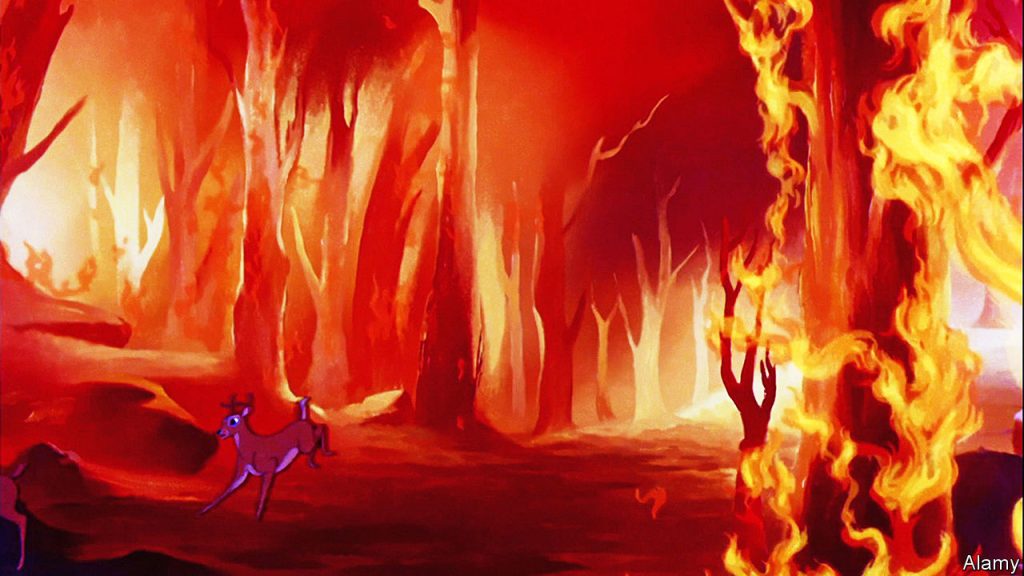
Mind you, the artists at Walt Disney Animation Studios had lots of inspiration for the forest fire sequence in “Bambi.” You see, in a typical year, the United States experiences – due to either natural phenomenon like lightning strikes or human carelessness – 100 forest fires. Whereas in 1940 (i.e., the year that Disney Studios began working in earnest of a movie version of Felix Salten’s best-selling movie), America found itself battling a record 360 forest fires.
Which greatly concerned the U.S. Forest Service. But not for the reason you might think.
Protecting the Forest for World War II
I mean, yes. Sure. Officials over in the Agricultural Department (That’s the arm of the U.S. government that manages the Forest Service) were obviously concerned about the impact that this record number of forest fires in 1940 had had on citizens. Not to mention all of the wildlife habitat that was now lost.
But to be honest, what really concerned government officials was those hundreds of thousands of acres of raw timber that had been consumed by these blazes. You see, by 1940, the world was on the cusp of the next world war. A conflict that the U.S. would inevitably be pulled into. And all that now-lost timber? It could have been used to fuel the U.S. war machine.
So with this in mind (and U.S. government officials now seeing an urgent need to preserve & protect this precious resource) … Which is why – in 1942 (just a few months after the Japanese bombed Pearl Harbor) – the U.S. Forest Service rolls out its first-ever forest fire prevention program.
Which – given that this was the early days of World War II – the slogan that the U.S. Forest Service initially chose for its forest fire prevention program is very in that era’s we’re-all-in-this-together / so-let’s-do-what-we-can-to-help-America’s war-effort esthetic – made a direct appeal to all those folks who were taking part in scrap metal drives: “Forest Defense is National Defense.”

And the poster that the U.S. Forest Service had created to support this campaign? … Well, it was well-meaning as well. It was done in the WPA style and showed men out in the forest, wielding shovels to ditch a ditch. They were trying to construct a fire break, which would then supposedly slow the forest fire that was directly behind them.
But the downside was … That “Forest Defense is National Defense” slogan – along with that poster which the U.S. Forest Service had created to support their new forest fire prevention program didn’t exactly capture America’s attention.
I mean, it was the War Years after all. A lot was going in the country at that time. But long story short: the U.S. Forest Service’s first attempt at launching a successful forest fire prevention program sank without a trace.
So what do you do in a situation like this? You regroup. You try something different.
Disney & Bambi to the Rescue
And within the U.S. government, the thinking now was “Well, what if we got a celebrity to serve as the spokesman for our new forest fire prevention program? Maybe that would then grab the public’s attention.”
The only problem was … Well, again, these are the War Years. And a lot of that era’s A-listers (people like Jimmy Stewart, Clark Gable, even Mel Brooks) had already enlisted. So there weren’t really a lot of big-name celebrities to choose from.
But then some enterprising official at the U.S. Forest Service came up with an interesting idea. He supposedly said “Hey, have you seen that new Disney movie? You know, the one with the deer? That movie has a forest fire in it. Maybe we should go talk with Walt Disney? Maybe he has some ideas about how we can better capture the public’s attention when it comes to our new forest fire prevention program?”
And it turns Walt did have an idea. Which was to use this government initiative as a way to cross-promote Disney Studio’s latest full-length animated feature, “Bambi.” Which been first released to theaters in August of 1942.
So Walt had artists at Disney Studio work up a poster that featured the grown-up versions of Bambi the Deer, Thumper the Rabbit & Flower the Skunk. As this trio stood in some tall grasses, they looked imploring out at whoever was standing in front of this poster. Above them was a piece of text that read “Please Mister, Don’t Be Careless.” And below these three cartoon characters was an additional line that read “Prevent Forest Fires. Greater Danger Than Ever!”
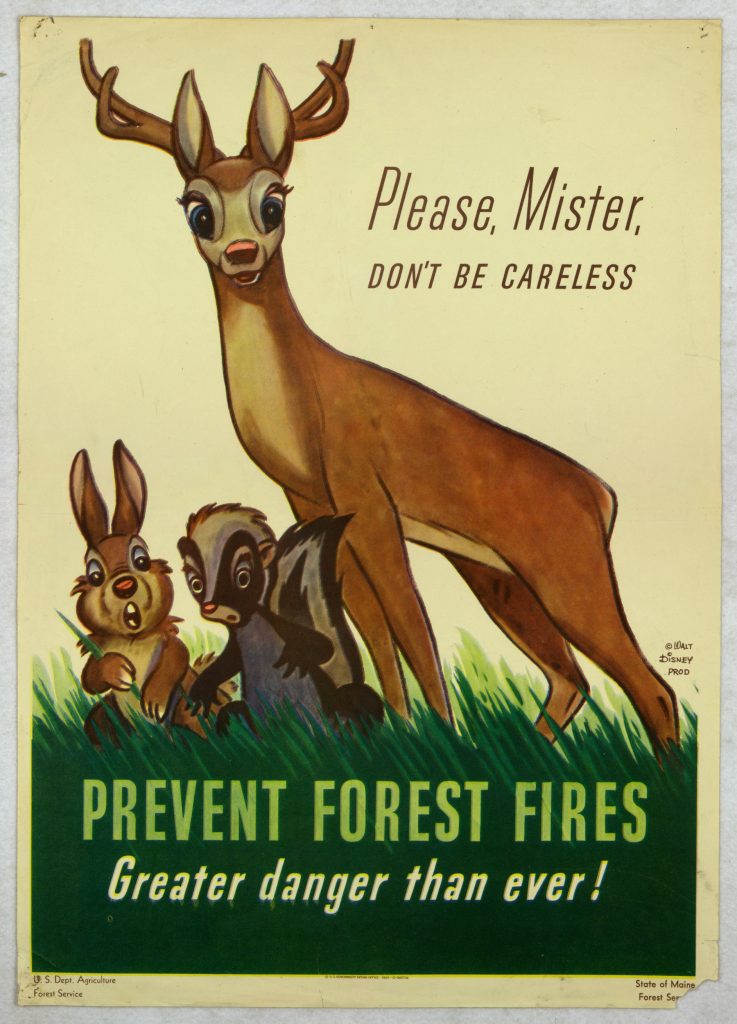
According to folks I’ve spoken with at Disney’s Corporate Archives, this “Bambi” -based promotional campaign for the U.S. Forest Service’s forest fire prevention campaign was a huge success. So much so that – as 1943 drew to a close – this division of the Department of Agriculture reportedly reached out to Walt to see if he’d be willing to let the U.S. Forest Service continue to use these cartoon characters to help raise the public’s awareness of fire safety.
Walt – for reasons known only to Mr. Disney – declined. Some have suggested that — because “Bambi” had actually lost money during its initial theatrical release in North America – that Walt was now looking to put that project behind him. And if there were posters plastered all over the place that then used the “Bambi” characters that then promoted the U.S.’s forest fire prevention efforts … Well, it would then be far harder for Mr. Disney to put this particular animated feature in the rear view mirror.
Introducing Smokey Bear
Long story short: Walt said “No” when it came to reusing the “Bambi” characters to promote the U.S. Forest Service’s forest fire prevention program. But given how successful the previous cartoon-based promotional campaign had been … Well, some enterprising employee at the Department of Agriculture reportedly said “Why don’t we come up with a cartoon character of our own?”
So – for the Summer of 1944 – the U.S. Forest Service (with the help of the Ad Council and the National Association of State Foresters) came up with a character to help promote the prevention of forest fires. And his name is Smokey Bear.
Now a lot of thought had gone into Smokey’s creation. Right from the get-go, it was decided that he would be an American black bear (NOT a brown bear or a grizzly). To make this character seem approachable, Smokey was outfitted with a ranger’s hat. He also wore a pair of blue jeans & carried a bucket.
As for his debut poster, Smokey was depicted as pouring water over a still-smoldering campfire. And below this cartoon character was printed Smokey’s initial catchphrase. Which was “Care will prevent 9 out of 10 forest fires!”
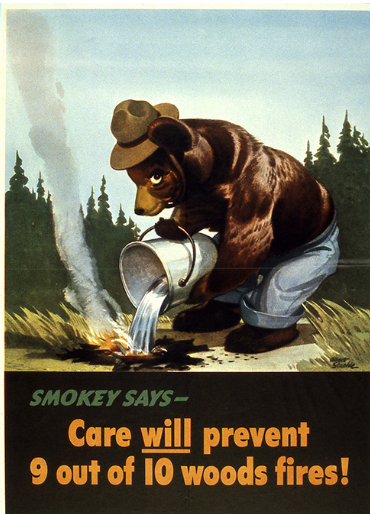
Which makes me think that this slogan was written by the very advertising executive who wrote “Four out of five dentists recommend sugarless gum for their patients who chew gum.”
Anyway … By the Summer of 1947, Smokey got a brand-new slogan. The one that he uses even today. Which is “Only YOU can prevent forest fires.”
The Real Smokey Bear
Now where this gets interesting is – in the Summer of 1950 – there was a terrible forest fire up in the Capitan Mountains of New Mexico. And over the course of this blaze, a bear cub climbed high up into a tree to try & escape those flames.
Firefighters were finally able to rescue that cub. But he was so badly injured in that fire that he was shipped off to the National Zoo in Washington, D.C. and nursed back to health. And since this bear really couldn’t be released back in the wild at this point, he was then put on exhibit.
And what does this bear’s keepers decide to call him? You guessed it: Smokey.
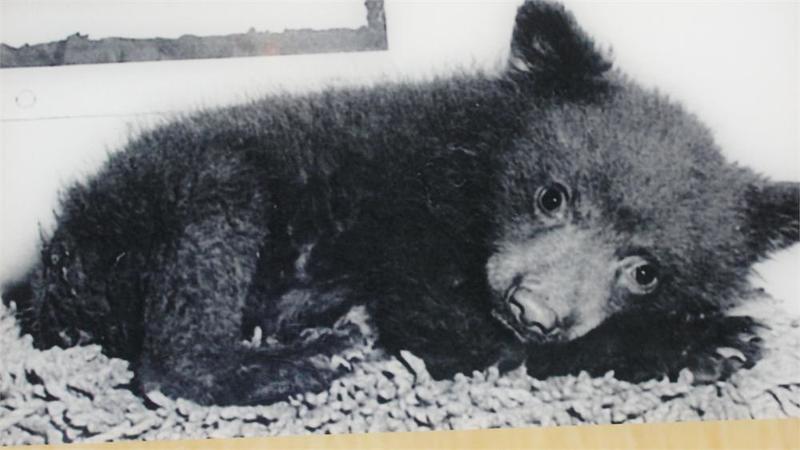
And due to all the news coverage that this orphaned bear got, he eventually became the living symbol of the U.S. Forest Service’s forest fire prevention program. Which then meant that this particular Smokey Bear got hit with a ton of fan mail. So much so that the National Zoo in Washington D.C. wound up with its own Zip Code.
“Smokey the Bear” Hit Song
And on the heels of a really-for-real Smokey Bear taking up residence in our nation’s capital, Steve Nelson & Jack Rollins decide to write a song that shined a spotlight on this fire-fightin’ bruin. Here’s the opening stanza:
With a ranger’s hat and shovel and a pair of dungarees,
You will find him in the forest always sniffin’ at the breeze,
People stop and pay attention when he tells them to beware
Because everybody knows that he’s the fire-preventin’ bear
Believe or not, even with lyrics like these, “Smokey the Bear” briefly topped the Country charts in the Summer of 1950. Thanks to a version of this song that was recorded by Gene Autry, the Singing Cowboy.
By the way, it was this song that started all of the confusion in regards to Smokey Bear’s now. You see, Nelson & Rollins – because they need the lyrics of their song to scan properly – opted to call this fire-fightin’-bruin Smokey THE Bear. Rather than Smokey Bear. Which has been this cartoon character’s official name since the U.S. Forest Service first introduced him back in 1944.
“The Ballad of Smokey the Bear”
Further complicating this issue was “The Ballad of Smokey the Bear,” which was a stop-motion animated special that debuted on NBC in late November of 1966. Produced by Rankin-Bass as a follow-up to their hugely popular “Rudolph the Red-Nosed Reindeer” (which premiered on the Peacock Network in December of 1964) … This hour-long TV show also put a “THE” in the middle of Smokey Bear’s name because the folks at Rankin-Bass thought his name sounded better that way.
And speaking of animation … Disney’s “Bambi” made a brief return to the promotional campaign for the U.S. Forest Service’s forest fire prevention program in the late 1980s. This was because the Company’s home entertainment division had decided to release this full-length animated feature on VHS.
What’s kind of interesting, though, is the language used on the “Bambi” poster is a wee different than the language that’s used on Smokey’s poster. It reads “Protect Our Forest Friends. Only You Can Prevent Wildfires.” NOT “Forest Fires.”
Anyway, that’s how Disney’s “Bambi” led to the creation of Smokey Bear. Thanks for bearin’ with me as I clawed my way through this grizzly tale.
Film & Movies
“Indiana Jones and the Search for Indiana Jones”
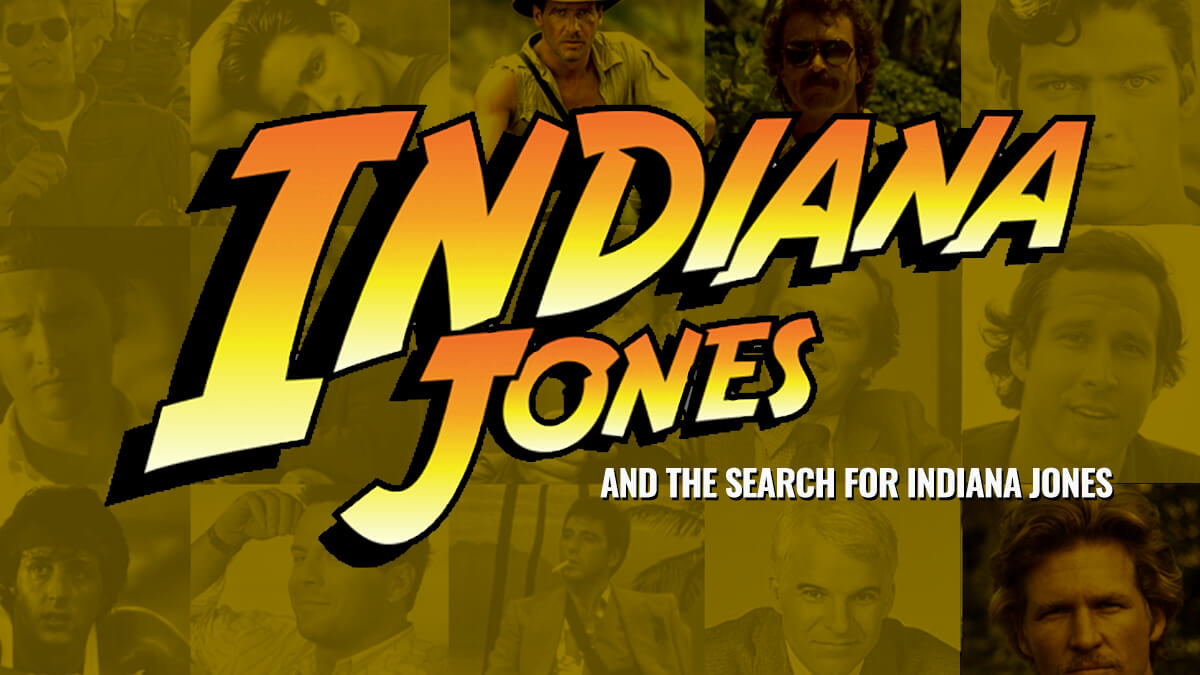
News came late last week that NBC was cancelling the “Magnum PI” remake. This series (which obviously took its inspiration from the Tom Selleck show that originally debuted on CBS back in December of 1980 and then went on run on that network for 8 seasons. With its final episode airing on May 8, 1988).
Anyway … Over 30 years later, CBS decided to remake “Magnum.” This version of the action drama debuted on September 24, 2018 and ran for four seasons before then being cancelled. NBC picked up the “Magnum” remake where it ran for one more season before word came down on June 23rd that this action drama was being cancelled yet again.
FYI: The second half of Season 5 of “Magnum” (10 episodes) has yet to air on NBC. It will be interesting to see when that final set of shows / the series finale gets scheduled.
This all comes to mind this week – out ahead of the theatrical release of “Indiana Jones and the Dial of Destiny” because … Well, if CBS execs had been a bit more flexible back in 1980, the star of the original version of “Magnum PI” (Tom Selleck) would have played the lead in “Raiders of the Lost Ark.” Which was released to theaters back on June 12, 1981.
That’s the part of the Indiana Jones story that the folks at Lucasfilm often opt to skim over.
That Harrison Ford wasn’t George Lucas’ first choice to play Doctor Jones.
Auditions for Indiana Jones – Harrison’s Not on the List
Mind you, Steven Spielberg – right from the get-go – had pushed for Ford to play this part. The way I hear it, Lucas showed Spielberg a work-in-progress cut of “The Empire Strikes Back.” And Steven was so taken with Harrison’s performance as Han Solo in that Irwin Kershner film that he immediately began pushing for Ford to be cast as Doctor Jones.
Whereas Mr. Lucas … I mean, it wasn’t that George had anything against Harrison. What with Ford’s performances first in “American Grafitti” and then in “A New Hope,” these two already had a comfortable working relationship.
But that said, Lucas was genuinely leery of … Well, the sort of creative collaboration that Martin Scorcese and Robert DeNiro. Where one actor & one director repeatedly worked together. To George’s way of thinking, that was a risky path to follow. Hitching your wagon to a single star.
Which is why – when auditions got underway for “Raiders of the Lost Ark” in 1979 — Mike Fenton basically brought in every big performer of that era to read for Dr. Jones except Harrison Ford. We’re talking:
- Steve Martin
- Chevy Chase
- Bill Murray
- Jack Nicholson
- Peter Coyote
- Nick Nolte
- Sam Elliot
- Tim Matheson
- and Harry Hamlin
Casting a Comedian for Indiana Jones
Please note that there are a lot of comedians on this list. That’s because – while “Raiders of the Lost Ark” was in development — Spielberg was directed his epic WWII comedy, “1941.” And for a while there, Steve & George were genuinely uncertain about whether the movie that they were about to make would be a sincere valentine to the movie serials of the 1930s & the 1940s or more of a spoof.
It’s worth noting here that three of the more ridiculous set pieces found in “Temple of Doom” …
- the shoot-out at Club Obi Wan in Shanghai
- Indy, Willie & Short Round surviving that plane crash by throwing an inflatable life raft out of the cargo hatch
- and that film’s mine cart chase (which was not only inspired by Disney theme park favorites the Matterhorn Bobsleds & Big Thunder Mountain Railroad but some of the sound effects that you hear in this portion of “Temple of Doom” were actually recorded after hours at Disneyland inside of these very same attractions)
… all originally supposed to be in “Raiders of the Lost Ark.” I’ve actually got a copy of the very first version of the screenplay that Lawrence Kasdan wrote for the first “Indy” movie where all three of these big action set pieces were supposed to be part of the story that “Raiders” told. And I have to tell you that this early iteration of the “Raiders” screenplay really does read more like a spoof of serials than a sincere, loving salute to this specific style of cinema.
Casting Indiana Jones – Jeff or Tom
Anyway … Back now to the casting of the male lead for “Raiders” … After seeing virtually every actor out in LA while looking for just the right performer to portray Indiana Jones, it all came down to two guys:
- Jeff Bridges
- and Tom Selleck
Jeff Bridges as Indiana Jones
Mike Fenton was heavily pushing for Jeff Bridges. Having already appeared with Clint Eastwood in 1974’s “Thunderbolt & Lightfoot” (Not to mention that “King Kong” remake from 1976), Bridges was a known quantity. But what Fenton liked especially liked about Bridges when it came to “Raiders” was … Well, at that time, Jeff was just coming off “Heaven’s Gate.”
Mind you, nowadays, because we’ve all now had the luxury of seeing the director’s cut of this Michael Cimino movie, we recognize “Heaven’s Gate” for the cinematic masterpiece that it is. But 40+ years ago, that honestly wasn’t the case. All audiences had to judge this movie by was the severely truncated version that United Artists sent out into theaters. Which – because “Heaven’s Gate” had cost $44 million to make and only sold $3.5 million of tickets – then became the textbook example of Hollywood excess.
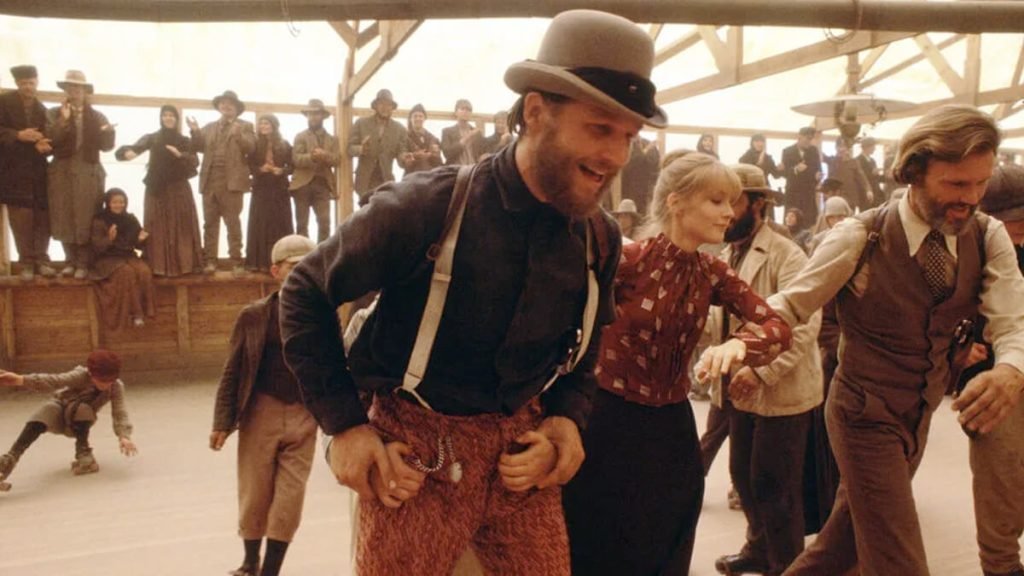
Long story short: Given that being associated with “Heaven’s Gate” had somewhat dinged Bridges’ reputation for being a marketable star (i.e., a performer that people would pay good money to see up on the big screen), Jeff was now looking to appear in something highly commercial. And the idea of playing the lead in a film directed by Steven Spielberg (the “Jaws” & “Close Encounter” guy) and produced by George Lucas (Mr. “Star Wars”) was very, very appealing at that time. Bridges was even willing to sign a contract with Spielberg & Lucas that would have then roped him into not only playing Indiana Jones in “Raider of the Lost Ark” but also to appear as this very same character in two yet-to-be-written sequels.
Better yet, because “Heaven’s Gate” had temporarily dimmed Bridges’ star status, Jeff was also willing to sign on to do the first “Indy” film for well below his usual quote. With the understanding that – should “Raiders of the Lost Ark” succeed at the box office – Bridges would then be paid far more to appear in this film’s two sequels.
That seemed like a very solid plan for “Raiders.” Landing a known movie star to play the lead in this action-adventure at a bargain price.
Ah, but standing in Mike Fenton’s way was Marcia Lucas.
Tom Selleck as Indiana Jones
Marcia Lucas, who had seen Tom Selleck’s audition for “Raiders” (And you can see it as well. Just go to Google and type in “Tom Selleck” and “Indiana Jones.” And if you dig around for a bit, you’ll then see a feature that Lucas & Spielberg shot for “Entertainment Tonight” back in 2008 [This story was done in support of the theatrical release of “Indiana Jones and the Kingdom of the Crystal Skull”]. And as part of this piece, George and Steve share Tom’s original audition for “Raiders.” And what’s genuinely fascinating about this footage is that Selleck’s scene partner is Sean Young. Who – at that time, anyway – was up for the role of Marion Ravenwood) and kept telling her husband, “You should cast this guy. He’s going to be a big star someday.”
And given that George was smart enough to regularly heed Marcia Lucas’ advice (She had made invaluable suggestions when it came to the editing of “American Graffiti” and the original “Star Wars.” Not to downplay George Lucas’ cinematic legacy, but Marcia Lucas was a world-class storyteller in and of her own right), Lucas then reached out to Spielberg and persuaded him that they should cast relative unknown Tom Selleck as Doctor Jones over the already well-known Jeff Bridges.
Now don’t feel too bad for Jeff Bridges. When he lost out on playing the lead in “Raiders of the Lost Ark,” Jeff then accepted a role in the very next, high profile, sure-to-be-commercial project that came along. Which turned out to be Disney’s very first “TRON” movie. Which was eventually released to theaters on July 9, 1982.
Back to Tom Selleck now … You have to remember that – back then – Selleck was the handsome guy who’d already shot pilots for six different shows that then hadn’t gone to series. Which was why Tom was stuck being the guest star on shows like “The Fall Guy” and “Taxi.” Whereas once word got out around town that Selleck was supposed to play the lead in a project that Spielberg was directed & Lucas was producing … Well, this is when CBS decided that they’d now take the most recent pilot that Tom had shot and then go to series with this show.
That program was – of course – the original “Magnum PI.” And it’s at this point where our story started to get complicated.
“Magnum PI” – Two Out of Three Say “Yes”
Okay. During the first season of a TV show, it’s traditionally the network – rather than the production company (which – in this case – was Glen A. Larson Productions. The company behind the original versions of “Battlestar Galactica” & “Knight Rider”) or the studio where this series is actually being shot (which – in this case – was Universal Television) that has all the power. And in this particular case, the network execs who were pulling all the strings behind-the-scenes worked for CBS.
And when it came to the first season of “Magnum PI,” CBS had a deal with Glen A. Larson Productions and Universal Television which stated that the talent which had been contracted to appear in this new action drama would then be available for the production of at least 13 episodes with an option to shoot an additional 9 episodes (This is known in the industry as the back nine. As in: the last nine holes of a golf course).
Anyway, if you take those initial 13 episodes and then tack on the back nine, you then get 22 episodes total. Which – back in the late 1970s / early 1980s, anyway – was what a full season of a network television show typically consisted of.
Anyway … The contract that Selleck had signed with Glen A. Larson Productions, Universal Television & CBS stated that he had to be available when production of Season One of “Magnum PI” began in March of 1980. More to the point, Tom also had to be available should CBS exercise its option to air 22 episodes of this new series on that television network over the course of “Magnum PI” ‘s first season.
Which then made things complicated for George Lucas & Steven Spielberg because … Well, in order for “Raiders of the Lost Ark” to make its June 12, 1981 release date, that then meant that production of the first “Indy” movie would have to get underway no later than June 23, 1980.
But here’s the thing: Production of Season One of “Magnum PI” was scheduled to run through the first week of July of that same year (1980). So in order for Tom Selleck to play Indiana Jones in “Raiders,” he was going to need to be wrapped on production of “Magnum PI” by June 22, 1980 at the absolute latest.
So Spielberg & Lucas went to Glen A. Larsons Productions and asked if Selleck could please be sprung from his “Magnum PI” contractual obligations by June 22nd. And they said “Yes.” Then Steven & George went to Universal Television and asked executives there for their help in clearing Tom’s schedule so that he’d then be available to start work on “Raiders.” And they say “Yes” as well.
Spielberg & Lucas now go to CBS. But instead of the quick “Yeses” that they got from officials at Glen A. Larson Productions and Universal Television, it takes those suits at the Tiffany Network weeks before they then decided to say “No, they couldn’t release Tom Selleck early to go work on ‘Raiders’ “ because …
I’ve never really been able to get a straight answer here as to why CBS execs dug in their heels here. Why they flat-out refused to release Selleck early from his “Magnum PI” contractual obligation and allow him to go shoot “Raiders.”
Payback from “The Star Wars Holiday Special” Trash Talk
That said, it is worth noting that “The Star Wars Holiday Special” aired on CBS back in November of 1978. And given that – in the years that followed — Lucas wasn’t exactly shy when it came to saying how much he hated that two hour-long presentation (Or – for that matter – how George really regretted caving into the requests of CBS execs. Who had insisted that television stars long associated with the Tiffany Network – people like Art Carney, Harvey Korman & Bea Arthur – be given prominent guest starring roles in “The Star Wars Holiday Special”). And I’ve heard whispers over the years that CBS executives preventing Tom Selleck from appearing in “Raiders” could be interpreted as the Tiffany Network getting some payback for what George had said publicly about the “Star Wars Holiday Special.”
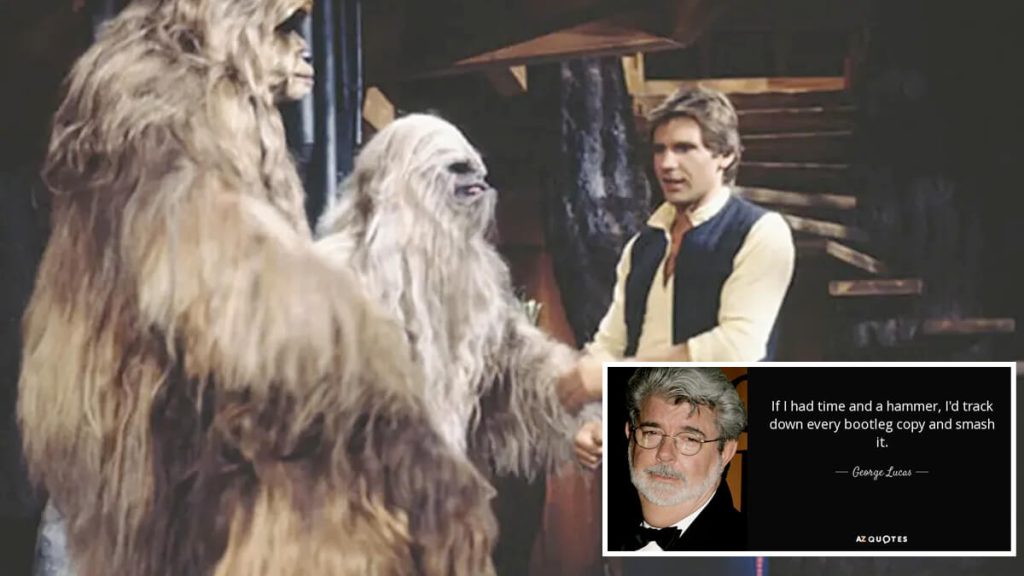
Harrison Ford Comes to Rescue “Indiana Jones”
Anyway … It’s now literally just weeks before production of “Raiders of the Lost Ark” is supposed to begin and Spielberg & Lucas have just learned that that they’ve lost their film’s star. CBS is flat-out refusing to release Tom Selleck early from his “Magnum PI” contractual obligation. So Steven & George now have to find someone else to play Indy … and fast.
The real irony here is … The American Federation of Television and Radio Artists would go on strike in the Summer of 1980. Which then shut prematurely shut down production of the first season of “Magnum PI.” (As a direct result, the first full season of this action drama to air on CBS only had 18 episodes, rather than the usual 22). And because this job action lasted ‘til October 23rd of that same year … Well, this meant that Tom Selleck would have actually been free to start shooting “Raiders of the Lost Ark” on June 23, 1980 because production of Season One of “Magnum PI” was already shut down by then due to that AFTRA strike.
But no one knew – in May of 1980, anyway – that this job action was going to happen in just a few weeks. All that Steven Spielberg & George Lucas knew was that they now needed a new lead actor for “Raiders.” And circling back on Jeff Bridges was no longer an option. As I mentioned earlier, Jeff had agreed to do “TRON” for Disney. And – in the interim – Bridges gone off to shoot “Cutter’s Way” for MGM / UA.
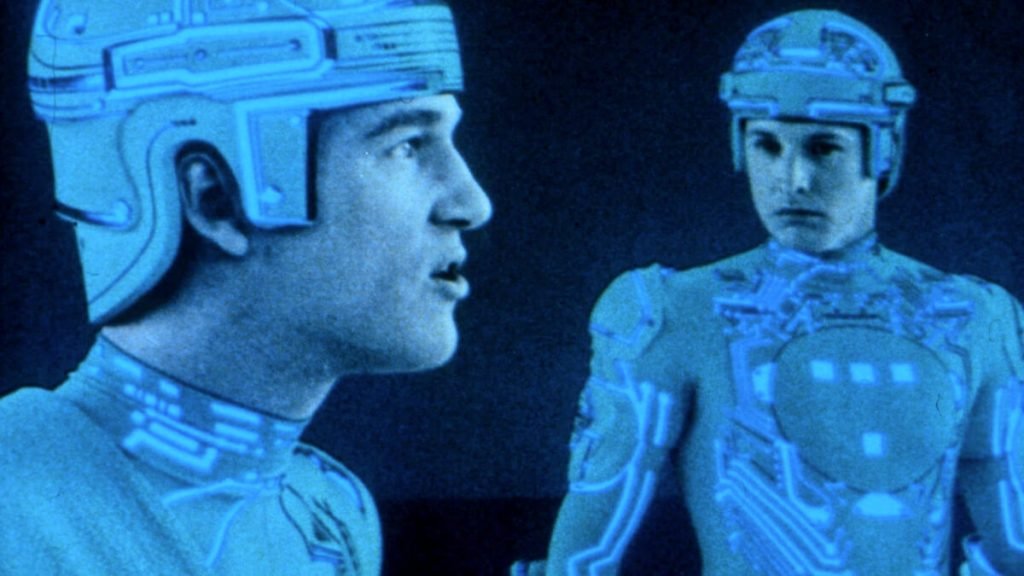
So this is where Harrison Ford enters the equation. As he recalls:
In May of 1980, I get a call from George Lucas. Who says ‘I’m messaging a script over to you this morning. As soon as it gets there, I need you to immediately read this script. Then – as soon as you’re done – I need you to call.
So the script arrives and it’s for ‘Raiders.’ I read it and it’s good. So I call George back and say ‘It’s good.’ And he then says ‘Would you be interested in playing Indy?’ I say that it looks like it would be a fun part to play.
George then says ‘ That’s great to hear. Because we start shooting in four weeks. Now I need you to meet with Steven Spielberg today and convince him that you’re the right guy to play Indy.’
Of course, given that Spielberg had been pushing for Ford to pay Indy ever since he had first seen that work-in-progress version of “The Empire Strikes Back” … Well, Harrison’s meeting with Steven was very, very short. And just a few weeks later, Spielberg, Lucas & Ford were all at the Port de la Pallice in La Rochelle. Where – on the very first day of shooting on “Raiders” (which – again – was June 23, 1980)– the scene that was shot was the one where that Nazi sub (the one that Indy had lashed himself to its periscope by using his bullwhip as a rope) was arriving at its secret base.
And all of this happened because Harrison immediately agreed to do “Raiders of the Lost Ark” when the part of Indy was first offered to him in mid-May of 1980.
Before “Star Wars” was “Star Wars”
So why such a quick yes? Well, you have to remember that “Empire Strikes Back” wouldn’t be released to theaters ‘til May 21, 1980. And no one knew at that time whether this sequel to the original “Star Wars” would do as well at the box office as “A New Hope” had back in 1977 (FYI: “Empire” would eventually sell over $500 million worth of tickets worldwide. Which is roughly two thirds of what the original “Star Wars” earned three years earlier).
More to the point, the four films that Harrison had shot right after “A New Hope” / prior to “Empire Strikes Back” (i.e., “Heroes” AND “Force 10 from Navarone” AND “Hanover Street” AND “The Frisco Kid”) had all under-performed at the box office. So to Ford’s way of thinking, taking on a role that Tom Selleck was no longer available to play – one that had the potential of spawning two sequels – seemed like a very smart thing to do. Especially after three years of cinematic stumbles.
By the way, whenever this topic ever comes up, Harrison Ford is very gracious. He always makes a point of saying that he’s grateful to have gotten this career opportunity. More to the point, that he still feels kind of bad that Tom Selleck never got the chance to play this part.
Tom Selleck After “Indiana Jones”
That said, we shouldn’t feel too bad for Tom Selleck. After all, the original “Magnum PI” proved to be a long running hit for CBS. And in an effort to smooth over any residual bad feelings that may have resulted from Tom being forced to give up “Raiders” back in May of 1980, Selleck was eventually allowed to create his own production company (i.e., T.W.S. Productions, Inc. As in Thomas William Selleck Productions). Which – after the fact – was then cut in on some of those “Magnum PI” -related revenue streams.
More to the point, while “Magnum PI” was on hiatus following its second year in production, Selleck flew off to Yugoslavia. Where he then shot his own Indiana Jones-esque film for theatrical release. Which was called “High Road to China” in the States, but – overseas – was promoted as “Raiders of the End of the World.”
FYI: Warner Bros. released “High Road to China” stateside 40 years ago this year. On March 18, 1983, to be exact. It didn’t do all that great at the box office. $28 million in ticket sales versus $15 million in production costs.
And over the years, there’s even been some talk of finding a way to maybe set things right here. By that I mean: Finally finding a way to officially fold Tom Selleck into the world of Indiana Jones.
Could Tom Selleck Work with Indiana Jones?
The way I hear it, between the time when “Indiana Jones and the Last Crusade” was theatrically released in May of 1989 and when “Indiana Jones and the Kingdom of the Crystal Skull” debuted in May of 2008, there were a number of ideas for Indiana Jones sequels tossed around. And from what I’ve been told, there was at least one treatment for a fourth Indiana Jones film written that proposed pairing up Harrison Ford & Tom Selleck. With the idea here being that Selleck was supposed to have played Ford’s brother.
Obviously that film was never made. And – no – I don’t know what state Indiana Jones’ brother was supposed to be named after.
This article is based on research for Looking at Lucasfilm “Episode 80”, published on June 29, 2023. Looking at Lucasfilm is part of the Jim Hill Media Podcast Network.
Film & Movies
Will “Metro” – that “Cars” Spin-Off Which Disney Developed – Ever Get Made?
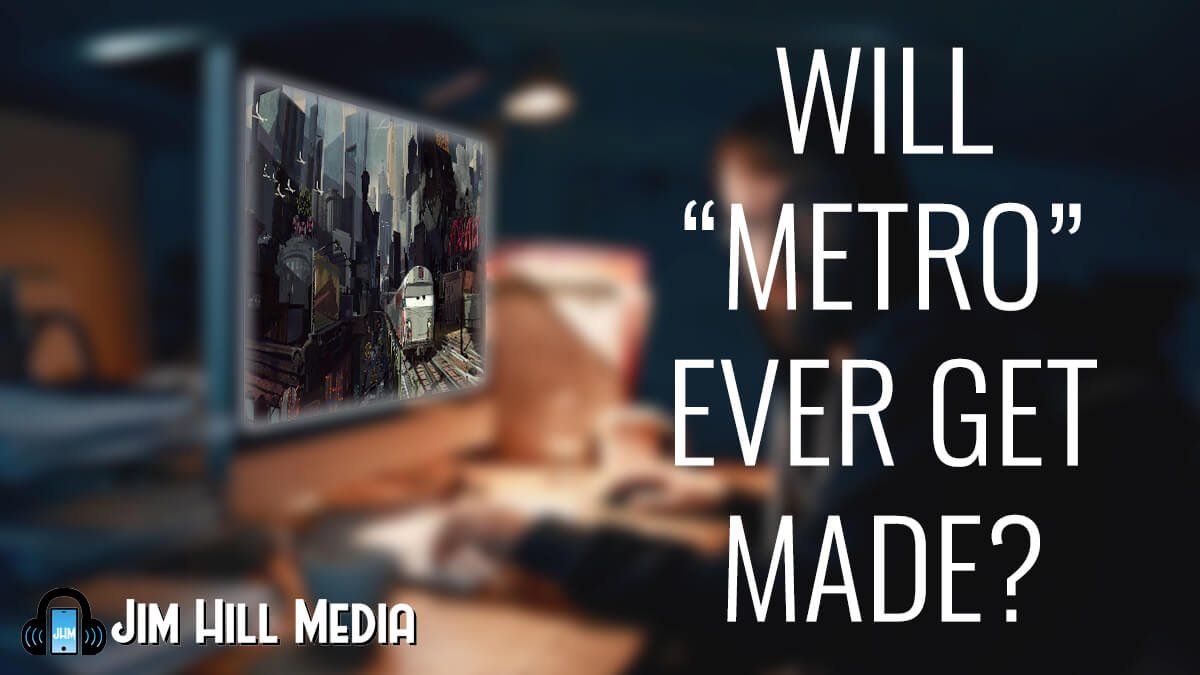
First came “Cars” in June of 2006.
This Pixar Animation Studios production did so well (Of all the high grossing films released that year, “Cars” was No. 2 at the box office. Only “Pirates of the Caribbean: Dead Man’s Chest” sold more tickets in 2006) that Disney execs asked John Lasseter to develop a sequel.
“Cars 2” came out in June of 2011 and also did quite well at the box office (It took the No. 7 slot in the Top-Ten-for-ticket-sales that year). Which is why Disney then asked Pixar to prep a follow-up film.
“Cars 3” would eventually arrive in theaters in June of 2017. But in the meantime, Disney & Pixar began exploring the idea of expanding this film franchise. Largely because the amount of money that the Mouse was making off of the sales of “Cars” -related merchandise was … To be blunt here, mind boggling.
Don’t believe me? Well, then consider this: In just the first five years that the “Cars” film franchise existed, global retail sales of merchandise related to these Pixar movies approached $10 billion. That’s billion with a “B.”
So is it any wonder that – while Pixar was still trying to get a handle on what “Cars 3” would actually be about – the Mouse (through its DisneyToon Studios arm. Which produced home premieres like those “TinkerBell” movies) began actively looking into ways to expand this lucrative franchise?
“Planes” – The First “Cars” Spin-Off
The first “Cars” spin-off to arrive in the marketplace was “Planes.” This Klay Hall film (which was set in “The World Above Cars”) was released theatrically in August of 2013, with the Blu-ray & DVD version of “Planes” hitting store shelves in November of that same year.
“Planes: Fire and Rescue” followed in the Summer of 2014. And while a “Planes 3” was definitely put in development (At the Disney Animation panel at the 2017 D23 Expo, John Lasseter not only shared a clip from this film. But he also revealed that this project – which, at that time, was entitled “Space” – was slated to be released theatrically in April of 2019) … This animated feature was abruptly cancelled when DisneyToon Studios was shuttered in June of 2018.
But wait. There’s more … In addition to the aborted “Planes 3,” Disney had other “Cars” spin-offs in the works. One was supposed to be built around boats. While yet another was supposed to have shined a spotlight on trucks.
“Metro” – The World Below Cars
And then there was “Metro.” Which was supposed to have been set in the inner city and focused on what went on in “The World Below Cars.” As in: Down in the subway system.
Just in the past week or so, a few pieces of concept art for “Metro” have surfaced online. Giving us all an intriguing look at what might have been. These preproduction paintings suggest that this “Cars” spin-off would be far grittier than … Say … the sort of adventures that Lightning McQueen & Mater would typically have out in Radiator Springs.
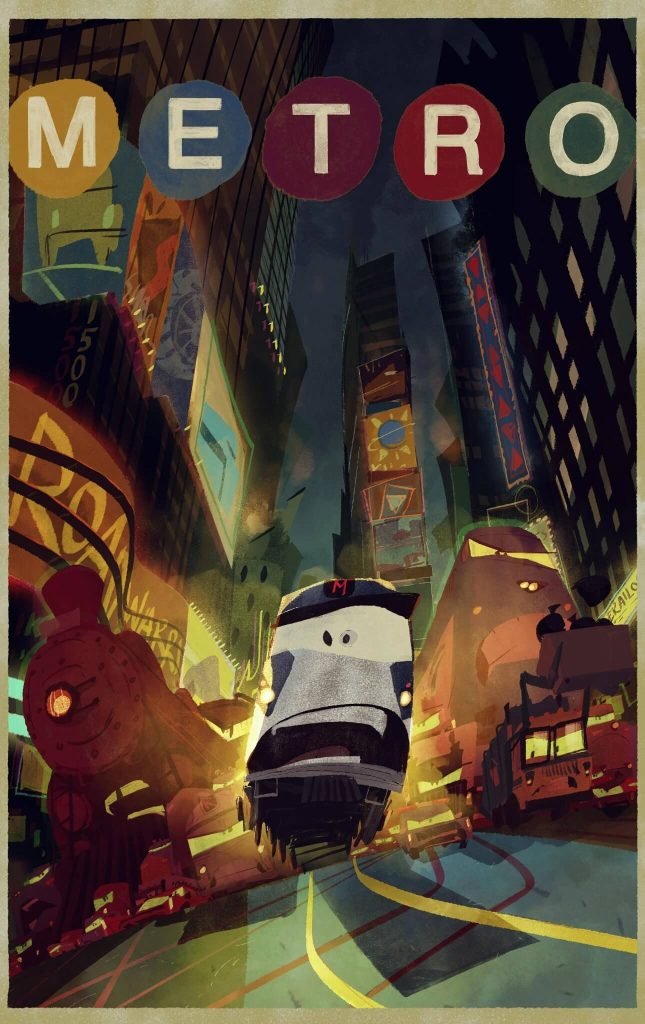
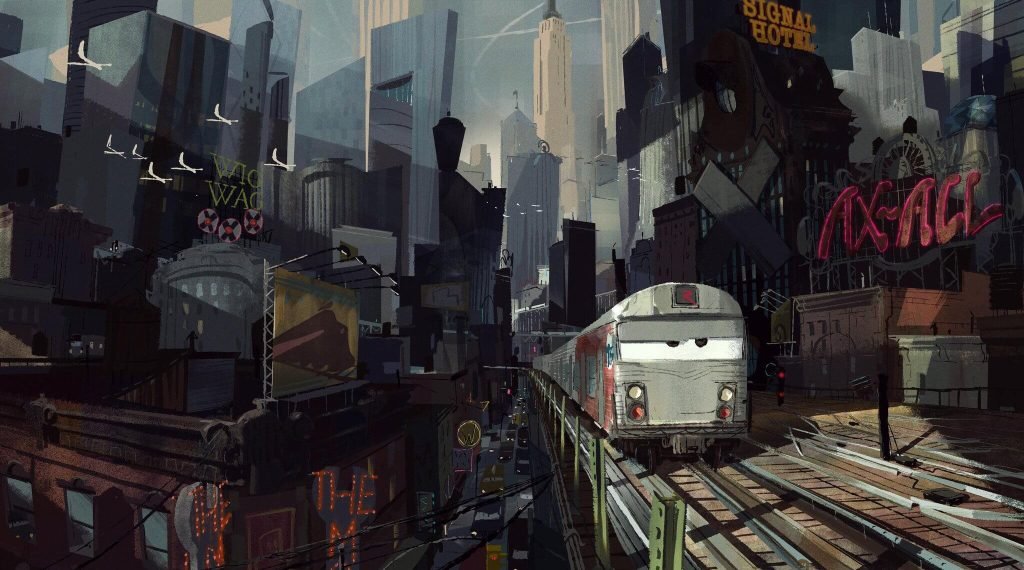
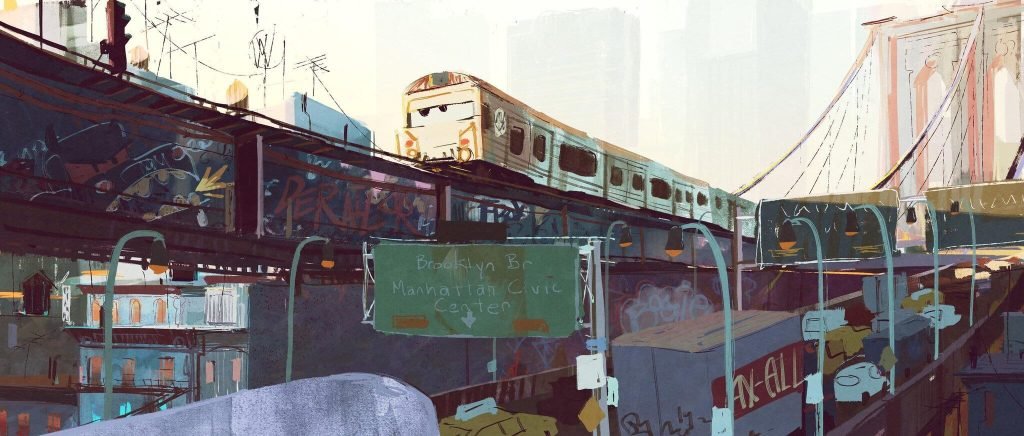
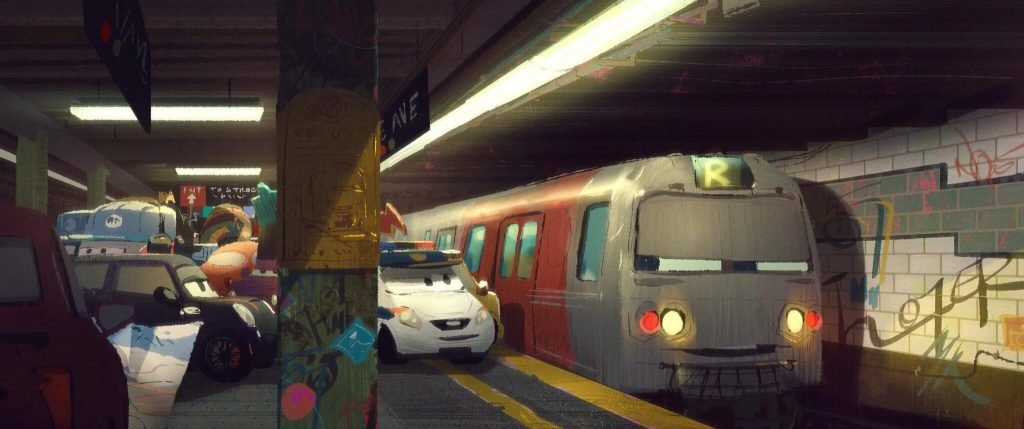
That said, it’s worth noting here that – just in the past year or so – we’ve seen Disney & Pixar attempt to expand the turf that these two characters could comfortably cover. Take – for example — “Cars on the Road,” that nine-part series which debuted on Disney+ back in September of last year. This collection of animated shorts literally sent Lightning McQueen & Mater off on a road trip.
So who knows?
Given that Bob Iger (at Disney’s quarterly earnings call held earlier this week) revealed that the Company now has sequels in the works for “Frozen,” “Toy Story,” and “Zootopia” … Well, is it really all that far-fetched to think that – at some point further on down the road – Disney & Pixar will put yet another sequel to “Cars” in the works?
One that might send Lightning McQueen & Mater off to explore the gritty inner-city world that we glimpsed in all that concept art for “Metro,” that never-produced “Cars” spin-off.
Time will tell.
-
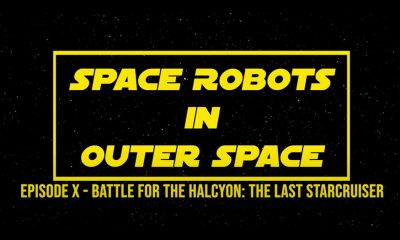
 News & Press Releases12 months ago
News & Press Releases12 months agoStar Wars Spoof: Space Robots in Outer Space Ep X: Battle for the Halcyon: The Last Starcruiser
-

 History11 months ago
History11 months ago31 Long-Gone Rides, Shows & Attractions at Disney-MGM (Hollywood Studios)
-

 News & Press Releases8 months ago
News & Press Releases8 months agoDisney Will Bring D23: The Ultimate Disney Fan Event to Anaheim, California in August 2024
-

 Theme Parks & Themed Entertainment12 months ago
Theme Parks & Themed Entertainment12 months agoFrom Aladdin to Indy – How Did We Get an Indiana Jones Stage Show at Disneyland?
-

 History4 months ago
History4 months agoFrom Birthday Wishes to Toontown Dreams: How Toontown Came to Be
-

 Theme Parks & Themed Entertainment12 months ago
Theme Parks & Themed Entertainment12 months agoHow Did We Get “Aladdin’s Oasis” at Disneyland?
-

 Film & Movies10 months ago
Film & Movies10 months ago“Indiana Jones and the Search for Indiana Jones”
-

 Theme Parks & Themed Entertainment10 months ago
Theme Parks & Themed Entertainment10 months agoWhen WDW Had a Racetrack – The Creation of the Walt Disney World Speedway








